
|
|

I
took over this e-zine when Gail, its originator was unable to continue it. With
Gail's permission, I have added her original Rock's of the Week so that everyone
can find the information readily. Please feel free to visit Gail's web site at http://www.davesrockshop.com. |
|
Garnet
(January birthstone)
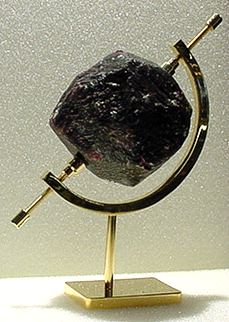
|
|
Scientific:
Garnet is the name of a family oemically related minerals that includes Almandine, Pyrope, Spessartine, Grossular and Andradite. They can all be found as gemstones with the Almandine Pyrope type being the type most commonly used. Because of their chemical compositions, garnet occurs in most colors other than blue. |
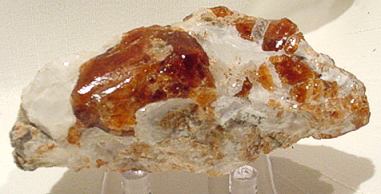
Garnet from Kunar, Afghanistan
|
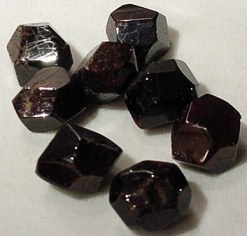
|
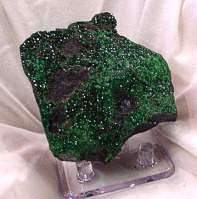
Uvarovite
|
Most garnets are
all deep shades of red, except for
Uvarovite which is green. The blood red color of pyrope is due to its iron and
cro-chromium content. It rarely has inclusions, but when present they are rounded crystals or have irregular outlines. Pyrope is found in volcanic rock luster and alluvial deposits and may, along with certain other minerals, indicate the presence of diamond- bearing rocks. Localities include the USA, South Africa, Argentina, Australia, Brazil, Myanmar, Scotland.
Garnets can be used by geologists as a gauge of how much temperature and pressure the rock has endured. Garnets are for the most part, considered minor gemstones, and some are not very valuable. Even though garnets have pretty colors, are wonderfully transparent, and are durable, thus making them good candidates for gemstones, many people consider garnets to be inferior to other colored gems. This may be due to garnet's relative abundance and widespread use, and therefore a (typically) low price. However,
uvarovites, tsavorites, and rhodolites are particularly valuable. |
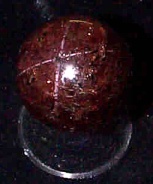
|
Hardness: 6.5 - 7.5
General garnet composition: A3B2(SiO4)3, where Ca, Mg,
Fe2 , or Mn2 occupy the A site, and the B site contains Al,
Fe3 or Cr3 . Hydrous garnets may contain up to 8.5%
H2O.
Chemical Composition of Common End-member Garnet Species
Pyralspite Garnet Group
Almandine: Fe3Al2(SiO4)3
Pyrope: Mg3Al2(SiO4)3
Spessartine: Mn3Al2(SiO4)3
Ugrandite Garnet Group
Andradite: Ca3Fe2(SiO4)3
Grossular: Ca3Al2(SiO4)3
Uvarovite: Ca3Cr2(SiO4)3
Less Common End-member Garnet Species
Calderite: Mn3Fe3 2(SiO4)3
Goldmanite: Ca3V2(SiO4)3
Hydrogrossular: Ca3Al2(SiO4)3-x(OH)4x
Hibschite: Ca3Al2(SiO4)3-x(OH)4x (where x is between 0.2 and 1.5)
Katoite: Ca3Al2(SiO4)3-x(OH)4x (where x is greater than 1.5)
Kimzeyite: Ca3(Zr,Ti)2[(Si,Al,Fe3 )O4]3
Knorringite: Mg3Cr2(SiO4)3
Majorite: Mg3(Fe,Al,Si)2(SiO4)3, discovered in a meteorite!
Morimotoite: Ca3Ti4 Fe2 (SiO4)3
Schorlomite: Ca3(Ti4 ,Fe3 )2[(Si,Ti)O4]3 |
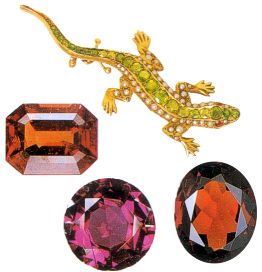
|
|
History:
"Garnet" may come from pomum granatum, Latin for pomegranate. The gem color of the Almandine Pyrope group is similar to that of a pomegranate. Garnets have a long factual and mythical history. They were popular for jewelry in the 18th and 19th centuries. It was a mark of distinction to use slices of garnet in the windows of churches and temples. Legend has it, that Noah suspended a finely cut, glowing garnet to illuminate the ark.
Myth:
In medieval times garnets were thought to cure depression, protect against bad dreams and relieve diseases of the liver and hemorrhages. The Amazon women were said to been empowered by the garnets they wore on their breastplates. |
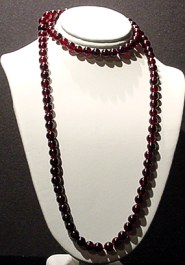
|
Metaphysical:
Garnets are good for the 1st, or base, chakra. It is the stone of new beginnings, especially because it is the birthstone of January. This is a stone of commitment and fidelity, especially for women (this is one of the reasons it was so popular in jewelry).
Wearing the red garnets, because they are the color of blood, promotes good circulation, especially in the lower half of the body. Thus, they are also good for fertility. They help promote passion between lovers.
Wearing the green garnets promotes great vitality and growth as well as attracting abundance. |
|










